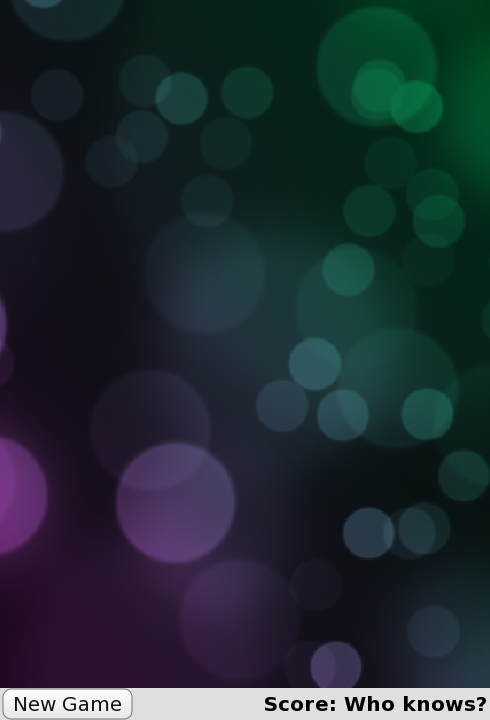QML Advanced Tutorial 1 - Creating the Game Canvas and Blocks
创建应用程序屏幕
第一步是在应用程序中创建基本的QML项目。
首先,我们创建一个相同的游戏应用程序与主屏幕像这样:

这是由主应用程序文件samegame.qml定义的,它如下所示:
import QtQuick 2.0 Rectangle { id: screen width: 490; height: 720 SystemPalette { id: activePalette } Item { width: parent.width anchors { top: parent.top; bottom: toolBar.top } Image { id: background anchors.fill: parent source: "../shared/pics/background.jpg" fillMode: Image.PreserveAspectCrop } } Rectangle { id: toolBar width: parent.width; height: 30 color: activePalette.window anchors.bottom: screen.bottom Button { anchors { left: parent.left; verticalCenter: parent.verticalCenter } text: "New Game" onClicked: console.log("This doesn't do anything yet...") } Text { id: score anchors { right: parent.right; verticalCenter: parent.verticalCenter } text: "Score: Who knows?" } } }
这给了一个基本的游戏窗口,包括块的主画布,“新游戏”按钮和分数显示。
One item you may not recognize here is the SystemPalette item. This provides access to the Qt system palette and is used to give the button a more native look-and-feel.
Notice the anchors for the Item, Button and Text types are set using group (dot) notation for readability.
Adding Button and Block components
The Button item in the code above is defined in a separate component file named Button.qml. To create a functional button, we use the QML types Text and MouseArea inside a Rectangle. Here is the Button.qml code:
import QtQuick 2.0 Rectangle { id: container property string text: "Button" signal clicked width: buttonLabel.width + 20; height: buttonLabel.height + 5 border { width: 1; color: Qt.darker(activePalette.button) } antialiasing: true radius: 8 // color the button with a gradient gradient: Gradient { GradientStop { position: 0.0 color: { if (mouseArea.pressed) return activePalette.dark else return activePalette.light } } GradientStop { position: 1.0; color: activePalette.button } } MouseArea { id: mouseArea anchors.fill: parent onClicked: container.clicked(); } Text { id: buttonLabel anchors.centerIn: container color: activePalette.buttonText text: container.text } }
This essentially defines a rectangle that contains text and can be clicked. The MouseArea has an onClicked() handler that is implemented to emit the clicked() signal of the container when the area is clicked.
In Same Game, the screen is filled with small blocks when the game begins. Each block is just an item that contains an image. The block code is defined in a separate Block.qml file:
import QtQuick 2.0 Item { id: block Image { id: img anchors.fill: parent source: "../shared/pics/redStone.png" } }
At the moment, the block doesn't do anything; it is just an image. As the tutorial progresses we will animate and give behaviors to the blocks. We have not added any code yet to create the blocks; we will do this in the next chapter.
We have set the image to be the size of its parent Item using anchors.fill: parent. This means that when we dynamically create and resize the block items later on in the tutorial, the image will be scaled automatically to the correct size.
Notice the relative path for the Image type's source property. This path is relative to the location of the file that contains the Image type. Alternatively, you could set the Image source to an absolute file path or a URL that contains an image.
You should be familiar with the code so far. We have just created some basic types to get started. Next, we will populate the game canvas with some blocks.
Files: